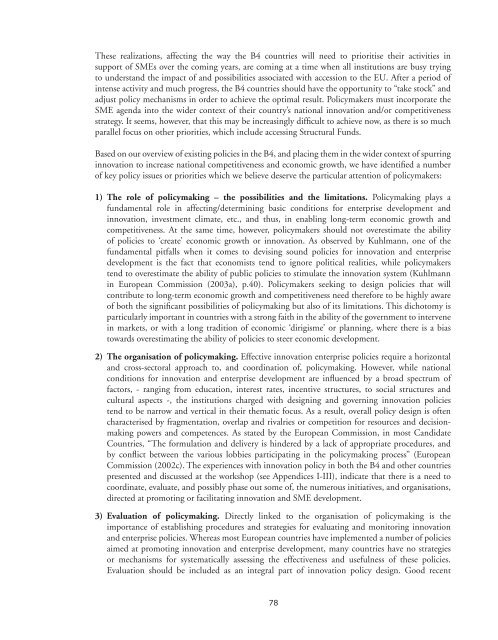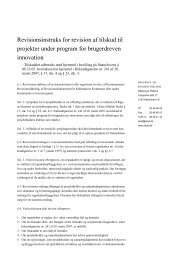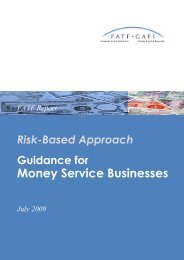These realizations, affect<strong>in</strong>g <strong>the</strong> way <strong>the</strong> B4 countries will need to prioritise <strong>the</strong>ir activities <strong>in</strong>support of <strong>SMEs</strong> over <strong>the</strong> com<strong>in</strong>g years, are com<strong>in</strong>g at a time when all <strong>in</strong>stitutions are busy try<strong>in</strong>gto underst<strong>and</strong> <strong>the</strong> impact of <strong>and</strong> possibilities associated with accession to <strong>the</strong> EU. After a period of<strong>in</strong>tense activity <strong>and</strong> much progress, <strong>the</strong> B4 countries should have <strong>the</strong> opportunity to “take stock” <strong>and</strong>adjust policy mechanisms <strong>in</strong> order to achieve <strong>the</strong> optimal result. Policymakers must <strong>in</strong>corporate <strong>the</strong>SME agenda <strong>in</strong>to <strong>the</strong> wider context of <strong>the</strong>ir country’s national <strong>in</strong>novation <strong>and</strong>/or competitivenessstrategy. It seems, however, that this may be <strong>in</strong>creas<strong>in</strong>gly difficult to achieve now, as <strong>the</strong>re is so muchparallel focus on o<strong>the</strong>r priorities, which <strong>in</strong>clude access<strong>in</strong>g Structural Funds.Based on our overview of exist<strong>in</strong>g policies <strong>in</strong> <strong>the</strong> B4, <strong>and</strong> plac<strong>in</strong>g <strong>the</strong>m <strong>in</strong> <strong>the</strong> wider context of spurr<strong>in</strong>g<strong>in</strong>novation to <strong>in</strong>crease national competitiveness <strong>and</strong> economic growth, we have identified a numberof key policy issues or priorities which we believe deserve <strong>the</strong> particular attention of policymakers:1) The role of policymak<strong>in</strong>g – <strong>the</strong> possibilities <strong>and</strong> <strong>the</strong> limitations. Policymak<strong>in</strong>g plays afundamental role <strong>in</strong> affect<strong>in</strong>g/determ<strong>in</strong><strong>in</strong>g basic conditions for enterprise development <strong>and</strong><strong>in</strong>novation, <strong>in</strong>vestment climate, etc., <strong>and</strong> thus, <strong>in</strong> enabl<strong>in</strong>g long-term economic growth <strong>and</strong>competitiveness. At <strong>the</strong> same time, however, policymakers should not overestimate <strong>the</strong> abilityof policies to ‘create’ economic growth or <strong>in</strong>novation. As observed by Kuhlmann, one of <strong>the</strong>fundamental pitfalls when it comes to devis<strong>in</strong>g sound policies for <strong>in</strong>novation <strong>and</strong> enterprisedevelopment is <strong>the</strong> fact that economists tend to ignore political realities, while policymakerstend to overestimate <strong>the</strong> ability of public policies to stimulate <strong>the</strong> <strong>in</strong>novation system (Kuhlmann<strong>in</strong> European Commission (2003a), p.40). Policymakers seek<strong>in</strong>g to design policies that willcontribute to long-term economic growth <strong>and</strong> competitiveness need <strong>the</strong>refore to be highly awareof both <strong>the</strong> significant possibilities of policymak<strong>in</strong>g but also of its limitations. This dichotomy isparticularly important <strong>in</strong> countries with a strong faith <strong>in</strong> <strong>the</strong> ability of <strong>the</strong> government to <strong>in</strong>tervene<strong>in</strong> markets, or with a long tradition of economic ‘dirigisme’ or plann<strong>in</strong>g, where <strong>the</strong>re is a biastowards overestimat<strong>in</strong>g <strong>the</strong> ability of policies to steer economic development.2) The organisation of policymak<strong>in</strong>g. Effective <strong>in</strong>novation enterprise policies require a horizontal<strong>and</strong> cross-sectoral approach to, <strong>and</strong> coord<strong>in</strong>ation of, policymak<strong>in</strong>g. However, while nationalconditions for <strong>in</strong>novation <strong>and</strong> enterprise development are <strong>in</strong>fluenced by a broad spectrum offactors, - rang<strong>in</strong>g from education, <strong>in</strong>terest rates, <strong>in</strong>centive structures, to social structures <strong>and</strong>cultural aspects -, <strong>the</strong> <strong>in</strong>stitutions charged with design<strong>in</strong>g <strong>and</strong> govern<strong>in</strong>g <strong>in</strong>novation policiestend to be narrow <strong>and</strong> vertical <strong>in</strong> <strong>the</strong>ir <strong>the</strong>matic focus. As a result, overall policy design is oftencharacterised by fragmentation, overlap <strong>and</strong> rivalries or competition for resources <strong>and</strong> decisionmak<strong>in</strong>gpowers <strong>and</strong> competences. As stated by <strong>the</strong> European Commission, <strong>in</strong> most C<strong>and</strong>idateCountries, “The formulation <strong>and</strong> delivery is h<strong>in</strong>dered by a lack of appropriate procedures, <strong>and</strong>by conflict between <strong>the</strong> various lobbies participat<strong>in</strong>g <strong>in</strong> <strong>the</strong> policymak<strong>in</strong>g process” (EuropeanCommission (2002c). The experiences with <strong>in</strong>novation policy <strong>in</strong> both <strong>the</strong> B4 <strong>and</strong> o<strong>the</strong>r countriespresented <strong>and</strong> discussed at <strong>the</strong> workshop (see Appendices I-III), <strong>in</strong>dicate that <strong>the</strong>re is a need tocoord<strong>in</strong>ate, evaluate, <strong>and</strong> possibly phase out some of, <strong>the</strong> numerous <strong>in</strong>itiatives, <strong>and</strong> organisations,directed at promot<strong>in</strong>g or facilitat<strong>in</strong>g <strong>in</strong>novation <strong>and</strong> SME development.3) Evaluation of policymak<strong>in</strong>g. Directly l<strong>in</strong>ked to <strong>the</strong> organisation of policymak<strong>in</strong>g is <strong>the</strong>importance of establish<strong>in</strong>g procedures <strong>and</strong> strategies for evaluat<strong>in</strong>g <strong>and</strong> monitor<strong>in</strong>g <strong>in</strong>novation<strong>and</strong> enterprise policies. Whereas most European countries have implemented a number of policiesaimed at promot<strong>in</strong>g <strong>in</strong>novation <strong>and</strong> enterprise development, many countries have no strategiesor mechanisms for systematically assess<strong>in</strong>g <strong>the</strong> effectiveness <strong>and</strong> usefulness of <strong>the</strong>se policies.Evaluation should be <strong>in</strong>cluded as an <strong>in</strong>tegral part of <strong>in</strong>novation policy design. Good recent78
examples of evaluations of national <strong>in</strong>novation policies <strong>and</strong>/or <strong>in</strong>novation systems can be found <strong>in</strong>Estonia, Sweden <strong>and</strong> F<strong>in</strong>l<strong>and</strong>.4) Underst<strong>and</strong><strong>in</strong>g <strong>the</strong> role of <strong>the</strong> public sector <strong>in</strong> <strong>and</strong> <strong>the</strong> importance of competition for<strong>in</strong>novation. European economies tend to dist<strong>in</strong>guish <strong>the</strong>mselves from o<strong>the</strong>r economies <strong>and</strong>regions by <strong>the</strong> fact that relatively large sectors, usually but not only <strong>the</strong> public sector, are shelteredfrom competition. The size of <strong>the</strong> public sector <strong>in</strong> Europe <strong>in</strong>creases its role <strong>in</strong> <strong>in</strong>novation-diffusion,“both as a user of technology <strong>and</strong> as a provider of skills, <strong>in</strong>frastructure <strong>and</strong> services” (Fagerberg<strong>in</strong> European Commission (2003a), p.19). In addition, however, it underl<strong>in</strong>es <strong>the</strong> importanceof <strong>the</strong> public sector’s capacity to underst<strong>and</strong> <strong>and</strong>, when appropriate, adjust policy to changes <strong>in</strong>technology, organisational structures, nature <strong>and</strong> forms of <strong>in</strong>novation (networks, etc.), bus<strong>in</strong>essstrategies <strong>and</strong> practices, ways of do<strong>in</strong>g bus<strong>in</strong>ess, consumer patterns <strong>and</strong> dem<strong>and</strong>s, etc. Thus, <strong>the</strong>ascent of <strong>the</strong> knowledge economy <strong>and</strong> a well-function<strong>in</strong>g <strong>in</strong>novation system put new <strong>and</strong> highdem<strong>and</strong>s on <strong>the</strong> ability of all actors, <strong>in</strong>cl. academia <strong>and</strong> <strong>the</strong> public sector, to learn, absorb, adapt<strong>and</strong> <strong>in</strong>novate.5) The focus of policymak<strong>in</strong>g: As <strong>in</strong>novation policy matures <strong>in</strong> <strong>the</strong> Baltic <strong>and</strong> Nordic countries,<strong>the</strong>re is a realization that policy <strong>in</strong>itiatives have a tendency to focus on / or to be directed at researchperformers, ‘<strong>the</strong> top 10%’ of companies, not <strong>the</strong> bulk of enterprises. This is particularly <strong>the</strong> case for<strong>SMEs</strong>. In addition, when it comes to measur<strong>in</strong>g, as well as design<strong>in</strong>g <strong>and</strong> implement<strong>in</strong>g policiesfor promot<strong>in</strong>g <strong>in</strong>novation, <strong>the</strong>re also appears to be a bias <strong>in</strong> favour of technological <strong>in</strong>novation asopposed to o<strong>the</strong>r forms of <strong>in</strong>novation (process or organisational <strong>in</strong>novation, for example). Futurepolicies need to <strong>in</strong>clude measures targeted at encourag<strong>in</strong>g or facilitat<strong>in</strong>g <strong>in</strong>novation <strong>in</strong> ‘traditional’(as opposed to hi-tech or knowledge-<strong>in</strong>tensive) enterprises <strong>and</strong> sectors.6) The <strong>in</strong>struments of policymak<strong>in</strong>g: In design<strong>in</strong>g policies for streng<strong>the</strong>n<strong>in</strong>g <strong>in</strong>novation <strong>and</strong>enterprise development, <strong>the</strong>re is a tendency <strong>in</strong> many European countries to focus on policymeasures which fall with<strong>in</strong> <strong>the</strong> realm of <strong>the</strong> m<strong>in</strong>istry officially <strong>in</strong> charge of <strong>in</strong>novation policy,generally ei<strong>the</strong>r <strong>the</strong> M<strong>in</strong>istry of Industry/Economy or <strong>the</strong> M<strong>in</strong>istry of Research/Education.Thus, measures aimed at promot<strong>in</strong>g <strong>in</strong>novation <strong>and</strong> enterprise development tend to be focusedon provid<strong>in</strong>g startup assistance to <strong>SMEs</strong>, creat<strong>in</strong>g <strong>in</strong>stitutions for promot<strong>in</strong>g <strong>in</strong>dustry-academicl<strong>in</strong>kages, network<strong>in</strong>g, commercialisation of R&D, etc. While <strong>the</strong>se are important tools forstreng<strong>the</strong>n<strong>in</strong>g national <strong>in</strong>novation systems, <strong>the</strong>y tend to be overemphasized <strong>in</strong> policymak<strong>in</strong>g at<strong>the</strong> expense of o<strong>the</strong>r equally important areas, such as opportunities or possibilities (<strong>in</strong> terms ofaccess to venture capital, for example), capacities, <strong>and</strong> <strong>in</strong>centives for <strong>in</strong>novation <strong>and</strong> enterprisedevelopment.79
- Page 1 and 2:
Sylvia Schwaag SergerEmily HanssonC
- Page 4 and 5:
About the International Organisatio
- Page 7:
PREFACEAccession to the Single Mark
- Page 10 and 11:
enterprise development. There are n
- Page 12 and 13:
BOXESBox 1: The ‘Knowledge-Based
- Page 15 and 16:
INTRODUCTIONAfter more than 10 year
- Page 17 and 18:
CHAPTER 1: FROM STABILISATION TO IN
- Page 19:
increased competitive pressure as B
- Page 22 and 23:
Box 2: On Innovation and Innovation
- Page 24 and 25:
Table 5: GDP Growth 1995-2003 in Se
- Page 26 and 27:
Table 7: Relative Strengths and Wea
- Page 28 and 29:
Box 3: The Indicator ProblemExistin
- Page 31 and 32: CHAPTER 2:BALTIC SMEs - AGENTS OF F
- Page 33 and 34: Table 9: Average Annual Growth of S
- Page 35 and 36: Box 4: Overview of Selected Multina
- Page 37 and 38: The Role of SMEs in Transitional Ec
- Page 39 and 40: e to the potential advantage of the
- Page 41 and 42: A common measurement of business ac
- Page 43 and 44: Figure 8: Labour Productivity per P
- Page 45 and 46: Figure 10: Employment in Med/Hi-tec
- Page 47 and 48: Summing up, there are fewer economi
- Page 49 and 50: Overall, SMEs tend to lack the fina
- Page 51 and 52: Figure 12: Enterprises with Innovat
- Page 53 and 54: Figure 14: Proportion of Enterprise
- Page 55 and 56: Table 14: Barriers to Innovation fo
- Page 57 and 58: Some interesting examples of cluste
- Page 59 and 60: CHAPTER 3:POLICIES PROMOTING SMEs A
- Page 61 and 62: National governments themselves wil
- Page 63 and 64: Institutional StructureIn all of th
- Page 65 and 66: EU countries (innovation relay cent
- Page 67 and 68: LITHUANIAAgency/OrganisationLithuan
- Page 69 and 70: From the private sector, the chambe
- Page 71 and 72: On the whole, the B4 have relativel
- Page 73 and 74: LITHUANIAProgramme/Policy DocumentI
- Page 75 and 76: Table 19: B4 National Rankings of A
- Page 77 and 78: Box 11: Structural Funds to the Can
- Page 79: Box 12: On SMEs and FinancingIt doe
- Page 83 and 84: CHAPTER 4:CHALLENGES AND RECOMMENDA
- Page 85 and 86: General challengesBased on our own
- Page 87 and 88: the above-mentioned channels. 27 On
- Page 89 and 90: the EU average and particularly wit
- Page 91 and 92: RecommendationsBased on the challen
- Page 93 and 94: CHAPTER 5:A VISION OF A NORDIC-BALT
- Page 95 and 96: addition, they are the most advance
- Page 97 and 98: countries. One such sign is the rap
- Page 99 and 100: CONCLUSIONSEU accession will not re
- Page 101 and 102: REFERENCESAlfonso, Antonio, Ludger
- Page 103 and 104: European Commission (2003f), Compre
- Page 105 and 106: Eurostat (2004a), SMEs in the Candi
- Page 107 and 108: Statistical Office of Estonia (2004
- Page 109 and 110: APPENDIX I:Agenda for Working Group
- Page 111 and 112: DAY 2:POLICY SOLUTIONS9:30-10:30 In
- Page 113 and 114: APPENDIX II:Participants in the IKE
- Page 115 and 116: APPENDIX III:Conclusions from the I
- Page 117 and 118: APPENDIX IV:Summary of the Panel se
- Page 119 and 120: Regarding the role of policymaking,
- Page 121 and 122: APPENDIX V:Description of Field Stu
- Page 123 and 124: Mr. Miroslaw MarekMr. Talis Millers
- Page 126: IKED - International Organisation f
















